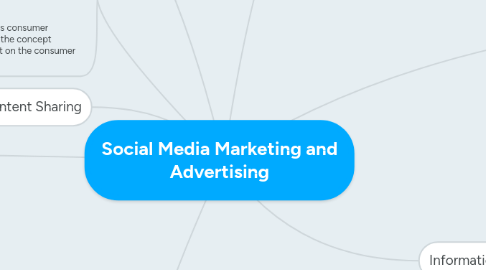
1. Social Media
1.1. "Social media is the collective of online communications channels dedicated to community-based input, interaction, content-sharing and collaboration." (http://whatis.techtarget.com/definition/social-media)
1.2. Social media is also known as consumer generated media relating to the concept creating and sharing content on the consumer side of the Internet.
2. Marketing
2.1. "Social media marketing is the process of gaining website traffic or attention through social media sites. Usually centered on efforts to create content that attracts attention and encourages readers to share it across their social networks." (https://en.wikipedia.org/wiki/Social_media_marketing)
3. Consequences
3.1. Reputation
3.1.1. Users feedback could be the pitfall to a companies success on social media. Consumers usually follow other peoples comments and criticism before anything.
3.2. Time
3.2.1. A company may not see any instant profits instantly from marketing and advertising on social media. Keeping a close eye on the interactions taking place within the companies social media page over time will gain more customers.
3.3. Control
3.3.1. Anyone is allowed to post publicly on social media and a companies product or service may backfire from criticism and comments resulting in a loss of consumers.
4. Content Sharing
4.1. The ability to create and share content freely on social media attracts companies to employ marketing and advertising strategies given the large number of active users.
5. Personal
5.1. Social media marketing and advertising is a large shift as to the traditional ways. It allows companies to build a more direct personal relationships with consumers.
6. Benefits
6.1. Branding
6.1.1. Branding is an essential part of Internet commerce, as branding allows companies to build their reputations as well as expand beyond the original product and service, and add to the revenue generated by the original brand.
6.2. Target Audience
6.2.1. Social media allows companies to learn more about their consumers personality and interest. Companies then can target consumers based on behaviors and interactions on social media.
6.3. SEO
6.3.1. Using social media as platform to promote a companies products or services increases there ranking on search engines. SEO stands for Search Engine Optimization where "the process of maximizing the number of visitors to a particular website by ensuring that the site appears high on the list of results returned by a search engine."
6.4. Community
6.4.1. Users that enjoy the product or services provided by companies can share it amongst other active users on social media. Also it allows you to connect the brand to the appropriate audience.
6.5. Feedback
6.5.1. Negative and positive feedback from consumers communities on social media allows for companies to taylor customers needs from their comments. Also allows for new ideas to evolve from the feedback given from consumers.
6.6. Increased Conversation Rate
6.6.1. Social media enhances the trust and credibility of companies brand by using consumers satisfaction to gain a larger audience resulting in higher site trafficking.
6.7. Economical
6.7.1. The price to produce information virtually is cheap as compared to physically. Marketers capitalize on creativity of their consumers to spread the companies message which cost little to nothing.
